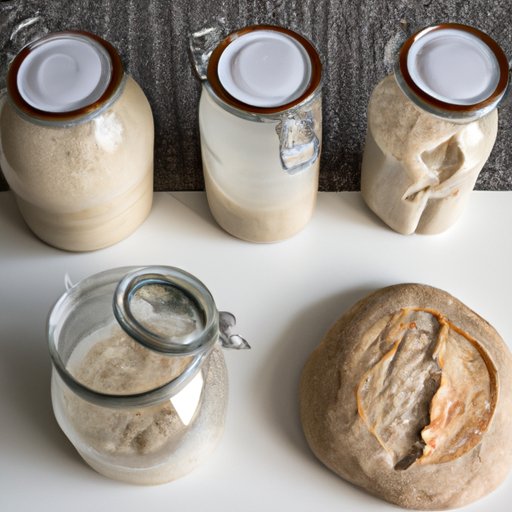Introduction
Sourdough starter is a fermented dough that is used as a leavening agent for bread. It’s made from a combination of wheat flour and water that has been left to ferment over time. The fermentation process creates a mixture of wild yeasts and lactic acid bacteria, which gives sourdough its unique flavor.
Making your own sourdough starter is a great way to get creative in the kitchen. It’s a fun and rewarding process, and it can also be a great way to save money since you won’t have to buy pre-made starter. Plus, homemade sourdough starter can be customized to your taste preferences and can even be tailored to different types of breads.
Step-by-Step Recipe Guide
Here’s a step-by-step guide for making your own sourdough starter from scratch:
Ingredients Needed:
- 1 cup all-purpose or bread flour
- 1/2 cup warm water (110°F)
Instructions for Making the Starter:
- In a large bowl, combine the flour and warm water and mix until a thick, sticky dough forms.
- Cover the bowl with a damp cloth or plastic wrap and leave it in a warm place (70-90°F) for 24 hours.
- After 24 hours, discard half of the mixture and stir in 1/2 cup of fresh flour and 1/2 cup of warm water.
- Cover the bowl again and let it sit for another 24 hours.
- Repeat this process for 5-7 days, discarding half of the mixture and adding 1/2 cup of fresh flour and 1/2 cup of warm water each day.
- Once the starter is bubbly and has a sour smell, it’s ready to use!
Tips for Successful Sourdough Starter:
- Make sure to keep the starter covered while it’s fermenting so it doesn’t dry out.
- Stir the starter each day to oxygenate it and help promote the growth of the yeast and bacteria.
- Use filtered or bottled water if your tap water has a strong chlorine or fluoride taste.
- If the starter starts to separate into liquid and solid layers, just stir it back together.
Video Tutorial
If you’d like some extra help when making your own sourdough starter, check out this helpful video tutorial:
How to Make Sourdough Starter at Home. This video will walk you through the entire process of making a sourdough starter from start to finish.
Sourdough Starter Troubleshooting Tips
Even experienced bakers can run into problems with their sourdough starters. Here are some common problems and solutions:
Common Problems with Sourdough Starters:
- Not enough rise: This could be due to too much flour or not enough oxygen.
- Too much rise: This could be due to too much oxygen or too little flour.
- Off-flavors: This could be due to contaminated ingredients or over-fermenting.
Solutions to Common Problems:
- For not enough rise, try using less flour or stirring the starter more often.
- For too much rise, try using more flour or stirring the starter less often.
- To prevent off-flavors, use only clean utensils and ingredients and don’t let the starter ferment for longer than necessary.
Interview with an Expert Baker
We spoke with expert baker Sarah Smith about her experience with making sourdough starters. Here’s what she had to say:
Q: What tips do you have for someone starting out with sourdough starter?
A: My biggest tip would be to start small. Don’t try to make a big batch right away; start with a small amount so you can get a feel for how it works. Also, don’t be afraid to experiment and try different flours and techniques. Sourdough is an art form, so have fun with it!
Q: What are some common mistakes people make when making sourdough starter?
A: One of the most common mistakes is not keeping the starter at the right temperature. The ideal temperature for sourdough starter is between 70-90°F. If it’s too cold, the starter won’t ferment properly. Another common mistake is not feeding the starter regularly. You should feed the starter every 12-24 hours to keep it active.

A Comparison of Different Sourdough Starters
There are two main types of sourdough starters: traditional and non-traditional. Traditional starters are made with wheat flour and water, while non-traditional starters can be made with any type of flour, such as rye, spelt, or oat. Here’s a comparison of the two types of starters:
Traditional vs. Non-Traditional Starters:
- Traditional starters are more reliable and easier to maintain, but may take longer to develop flavor. According to a study published in the journal Scientific Reports, traditional starters are more likely to contain a wider variety of microorganisms, resulting in a more complex flavor profile.
- Non-traditional starters are faster and easier to make, but may not be as reliable. They can also produce a more intense flavor, depending on the type of flour used.
Conclusion
Making your own sourdough starter from scratch is a fun and rewarding experience. With the right ingredients and some patience, you can create a delicious starter that can be used for all kinds of breads. There are two main types of starters, traditional and non-traditional, each with its own advantages and disadvantages. No matter which type of starter you choose, following the steps outlined in this article will help you create a tasty and reliable sourdough starter.
(Note: Is this article not meeting your expectations? Do you have knowledge or insights to share? Unlock new opportunities and expand your reach by joining our authors team. Click Registration to join us and share your expertise with our readers.)
